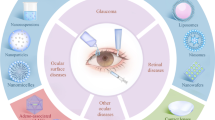Abstract
Purpose. Gentamicin eye drop solutions have a short precorneal residence time. The present study investigates the effect of gentamicin using a new long acting delivery Bioadhesive Ophthalmic Insert (BODI) in healthy dogs and rabbits and compares the results with a conventional regimen using an eye drop solution.
Methods. In vivo assays were performed on animals after deposition of one BODI and instillations of an eye drop solution. Tear samples were collected over 72 hours and 60 minutes, in the case of inserts and eye drop solution respectively. The gentamicin concentration profiles in tear fluid (determined by a fluorescent polarization immunoassay technique) was individually analyzed, in each animal, in relation with the minimum inhibitory concentration observed in vitro against some bacteria. A non classical pharmacokinetic approach was used for the analysis of the topically applied drug substance, involving two parameters: the efficacy area under the curve (AUCeff) and the efficacy time (teff).
Results. In the case of the eye drop solution, the AUCeff were higher in dogs (2.80 103 − 3.64 103 [µg ml−1 h]) than in rabbits (0.64 · 103 − 0.95 · 103 [µg ml−1h]); the teff had a similar behavior: 6-15 [h] in dogs and 2-6 [h] in rabbits. In the case of BODIs, the AUCeff and the teff were quite similar between dogs and rabbits: 190 103 − 205 103 [µg ml−1 h] and 70-76 [h], respectively. The AUCeff and the teffwere always much higher in the case of BODIs than for the eye drop solution both in dogs and rabbits.
Conclusions. This study shows that topical administration of gentamicin using BODIs can improve treatment due to the decreasing number of applications while ensuring an effective level of antibiotic in tears controlled by the device.
Similar content being viewed by others
REFERENCES
F. Q. Liang, R. S. Viola, M. del Cerrro, and V. Aquavella. Noncross-linked collagen discs and cross-linked collagen shields in the delivery of gentamicin to rabbits eyes. Invest. Ophthalmol. Vis. Sci. 33:2194–2198 (1992).
H. Ozawa, S. Hosaka, T. Kunitomo, and H. Tanzawa. Ocular inserts for controlled release of antibiotics. Biomaterials 4:170–174 (1983).
M. F. Saettone, B. Giannaccini, G. Marchesini, G. Galli, and E. Chiellini. Polymeric inserts for sustained ocular delivery of pilocarpine. Pol. Sci. Technol. 34:409–420 (1986).
J. L. Baum, M. Barza, D. Sushan, and L. Weinstein. Concentration of gentamicin in experimental corneal ulcers: topical vs subconjunctival therapy. Arch. Ophthalmol. 92:315–317 (1974).
J. R. Yuen, and G. S. Jaresko. Pharmacokinetics of ocular infections. J. Pharm. Prac. 9:247–268 (1991).
S. S. Chrai, M. C. Makoid, S. T. Eriksen, and J. R. Robinson. Lacrimal and instilled fluid dynamics in rabbit eyes. J. Pharm. Sci. 62:1112–1120 (1973).
S. S. Chrai, M. C. Makoid, S. P. Eriksen, and J. R. Robinson. Drop size and initial dosing frequency problems of topically applied ophthalmic drugs. J. Pharm. Sci. 63:333–338 (1974).
S. El-Shanaway. Ocular delivery of pilocarpine from ocular inserts. STP Pharm. Sci. 2:337–341 (1992).
F. Gurtler, and R. Gurny. Patent literature review of ophthalmic inserts. Drug Dev. Ind. Pharm. 21:1–18 (1995).
F. Gurtler, V. Kaltsatos, B. Boisramé, and R. Gurny. Long-acting ocular inserts for treatment of external infections in animals: clinical investigations. Conf. Proceed. International Symposium Controlled Release of Biactive Materials. Nice (France) 1994.
F. Gurtler, V. Kaltsatos, B. Boisramé, and R. Gurny. Long-acting ocular inserts for treatment of external infections in animals: clinical investigations. J. Contr. Rel. 33:231–236 (1995).
S. R. Popelka, D. M. Miller, J. T. Holen, and D. M. Kelso. Fluorescence polarization immunoassay II. Analyzer for rapid, precise measurement of fluorescence polarization with use of disposable cuvettes. Clin. Chem. 27:1198–1201 (1981).
M. E. Jolley, S. D. Stroupe, K. S. Schwenzer, C. J. Wang, M. Lu-Steffes, H. D. Hill, S. R. Popelka, J. T. Holen, and D. M. Kelso. Fluorescence polarization immunoassay III. An automated system for therapeutic drug determination. Clin. Chem. 27:1575–1579 (1981).
M. E. Jolley, S. D. Stroupe, C. H. J. Wang, H. N. Panas, C. L. Keegan, R. L. Schmidt, and K. S. Schwenzer. Fluorescence polarization immunoassay I. Monitoring aminoglycoside antibiotics in serum and plasma. Clin. Chem. 27:1190–1197 (1981).
Garamycin®, in: J. Morant and H. Ruppaner (eds.), Compendium Suisse des médicaments, Bâle: Documed; 1995: 761.
Author information
Authors and Affiliations
Rights and permissions
About this article
Cite this article
Gurtler, F., Kaltsatos, V., Boisramé, B. et al. Ocular Availability of Gentamicin in Small Animals After Topical Administration of a Conventional Eye Drop Solution and a Novel Long Acting Bioadhesive Ophthalmic Drug Insert. Pharm Res 12, 1791–1795 (1995). https://doi.org/10.1023/A:1016242528222
Issue Date:
DOI: https://doi.org/10.1023/A:1016242528222




